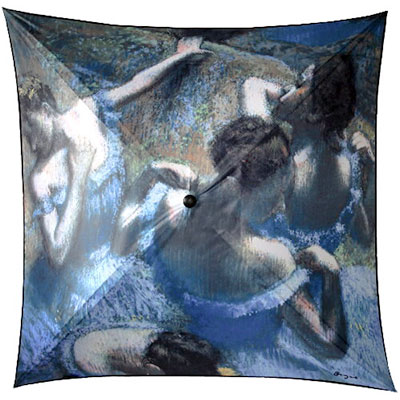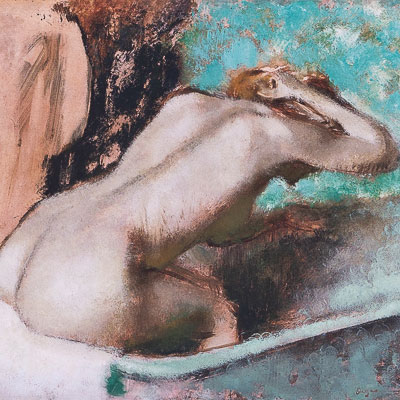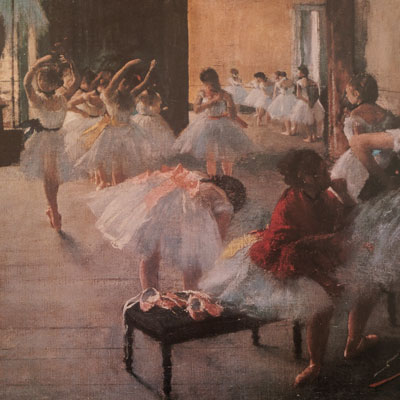Tel : (+33) 4 94 63 18 08
9am - 6pm from Monday to Sunday
All products Edgar Degas • Products of the topic Dance
Edgar Degas Bookmark : The Little Fourteen Years Old Dancer
REF : ED-MP-02
In stock
Only 1 in stock
Unavailable
15,00 €
(16.23 USD)
Edgar Degas Bookmark : The Little Fourteen Years Old Dancer
Solid brass, electro-plated with gold finish, giclee print
Dimensions : 3.2 x 7 cm
Born in 1834 in Paris, Edgar Degas brilliantly captured the grace of the human form in motion, and he is particularly renowned for his paintings, drawings, and sculptures of ballerinas. In the 1870s, Degas developed a passion for ballet dancers, becoming his preferred subject. His works often depict intricate compositions, blending the movement and repose of the dancers. To bring these scenes to life, Degas sketched from live models in his studio.
* * * * *
Dancers (Edgar Degas)
Dancers are one of the most iconic subjects in the work of Edgar Degas. He was particularly fascinated by the world of dance and dedicated a significant portion of his artistic career to portraying dancers in various contexts, whether in the dance studio, backstage, or even during rehearsals. He spent many hours observing and sketching dancers in motion, which is reflected in the precision of his works. He used natural poses and unusual angles to capture the movement and grace of dancers in authentic moments. He masterfully employed light to create intimate atmospheric effects, painting dancers illuminated by artificial light sources, thereby infusing life into each painting, making us feel the emotion and magic of the moment. His early works were characterized by academic precision, while his later works incorporated more impressionistic elements with looser brushstrokes and a brighter color palette. In 1881, Edgar Degas deviated from his usual practice of painting and drawing to bring to life a 14-year-old dancer in the form of a bronze and wax sculpture. This work is a masterpiece of realism and meticulous details in proportions, posture, and also costume details, adding a tutu of tulle, satin ribbons, and canvas ballet shoes, giving the work a three-dimensional quality that sets it apart from other art of the time.
Impressionism
The Impressionist movement in painting emerged in France in the 1870s and developed until the end of the 19th century. It was characterized by the use of light and color to capture impressions of the surrounding world, rather than accurately representing reality. Impressionists also used rapid brushstrokes and vibrant colors to capture the effect of changing light on objects and landscapes. The main Impressionist artists included Claude Monet, Edgar Degas, Pierre-Auguste Renoir, Camille Pissarro, and Berthe Morisot. Famous works by Monet include "Impression, Sunrise" (1872), "Water Lilies" (1905-1926), and "The Bridge at Argenteuil" (1874). Degas is known for his paintings of ballet scenes such as "The Dance Class" (1871) and "Dancers Resting" (1879), as well as numerous paintings of women bathing. Renoir is known for his paintings of everyday life scenes such as "The Ball at the Moulin de la Galette" (1876) and "The Large Bathers" (1884-1887). Pissarro produced many landscape paintings including "Place du Théâtre-Français" (1898) and "Boulevard Montmartre, Spring Morning" (1897). Morisot is known for her numerous paintings of women and everyday life scenes such as "The Boating Party" (1881) and "Young Girl at the Window" (1870). In addition to these famous artists, the Impressionist movement was also influenced by artists such as Paul Cézanne, Paul Gauguin, and Vincent Van Gogh. Cézanne is known for his landscape paintings of the area around his hometown of Aix-en-Provence, as well as his still life paintings. The Impressionist movement was initially criticized by art conservatives for several reasons. Firstly, Impressionists were criticized for their unconventional use of color and light. While traditional painters strived to represent colors accurately and realistically, Impressionists used brighter and more vibrant colors, and employed painting techniques like pointillism to create effects of light and movement. Secondly, Impressionists were criticized for their lack of respect for academic rules and traditional perspective. While academic painters strived to represent objects accurately and realistically, Impressionists chose to represent objects more abstractly and stylized, focusing on the sensations and emotions they wanted to convey rather than the precision of representation. Finally, the Impressionist movement was criticized for its lack of political and social substance. While many painters of the time engaged in important political and social subjects, Impressionists chose to focus on lighter and more everyday subjects, such as scenes of everyday life and landscapes. Due to these criticisms, the Impressionist movement had trouble finding an audience at first, and its members often had difficulty selling their works. However, the movement eventually gained popularity in the 1880s and 1890s and eventually became one of the most famous and influential artistic movements in history.
Discover the artist
Degas Edgar
Edgar Degas : Artistic products of the famous impressionist artist of the end of the 19th century ( 1834-1917 ). We propose a large choice of articles as umbrellas and silk scarves made in France, art jewelry or puzzles made in Italy.
Degas Edgar
Edgar Degas : Artistic products of the famous impressionist artist of the end of the 19th century ( 1834-1917 ). We propose a large choice of articles as umbrellas and silk scarves made in France, art jewelry or puzzles made in Italy.
Degas Edgar
Edgar Degas : Artistic products of the famous impressionist artist of the end of the 19th century ( 1834-1917 ). We propose a large choice of articles as umbrellas and silk scarves made in France, art jewelry or puzzles made in Italy.
Degas Edgar
Edgar Degas : Artistic products of the famous impressionist artist of the end of the 19th century ( 1834-1917 ). We propose a large choice of articles as umbrellas and silk scarves made in France, art jewelry or puzzles made in Italy.
Degas Edgar
Edgar Degas : Artistic products of the famous impressionist artist of the end of the 19th century ( 1834-1917 ). We propose a large choice of articles as umbrellas and silk scarves made in France, art jewelry or puzzles made in Italy.




































































































